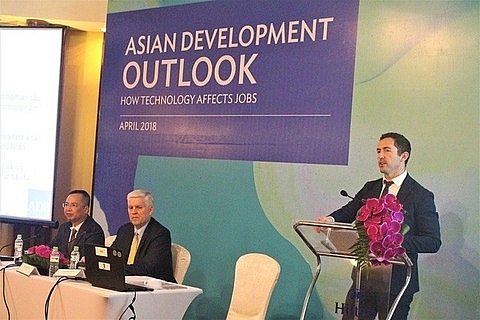Vietnam’s economy stablises in 2018
 |
| Fiscal consolidation, together with low inflation rates in 2018, are chief drivers for Viet Nam’s continuously stabilising macro economy in the context of rising global trade protectionism and turmoil, said the Asian Development Bank (ADB). - Photo dantri.com.vn |
According to the ADB’s 2018 Asian Development Outlook (ADO) released on Wednesday, Vietnam will continue to achieve a strong GDP growth of 7.1 per cent this year, before falling to 6.8 per cent in 2019.
"Aided by effective macroeconomic management, economic growth will spurt in 2018, with Vietnam becoming one of the strongest performers in the region," said Eric Sidgwick, ADB country director for Vietnam.
"Vietnam‘s robust economic growth will be driven by vigorous manufacturing and export expansion, rising domestic consumption, and strong investment fuelled by foreign direct investment (FDI) and domestic enterprises. All of this is coupled with an improving agriculture sector."
According to Sidgwick, the increase in fiscal revenue across all sectors of the government in 2017 helped reduce public debt to 61.3 per cent of GDP by the end of 2017, down from 63.6 per cent in 2016. Inflation will edge up but remain modest, and the current account surplus will narrow.
ADB forecasts that Vietnam’s 2018 inflation rate will average 3.7 per cent this year, up from 3.5 per cent in 2017, and reach 4 per cent in 2019, due to an increases in domestic demand and global commodity prices.
"Over the past decade, Vietnam has been able to mobilise an abundant supply of young, well educated workers to attract foreign investment into labour-intensive manufacturing," said Sidgwick.
Vietnam has long attracted large FDI inflows especially for labour-intensive export-oriented manufacturing. However, an emerging skills gap is acting as an obstacle to FDI absorption. This could be amended by an improved technical and vocational education and training (TVET) system focusing on expanding access, improving quality, and streamlining governance.
"If not addressed, this skills gap could become a major obstacle to Vietnam’s development aspirations," he added.
Alongside continued growth, Vietnam’s economy this year will still be facing risks and challenges. These include the need for state enterprise reform, negative debt, and an increase in global protectionism.
To overcome these challenges, ADB recommends that Vietnam restore its financial sustainability, consolidate its external balance, and control inflationary pressures. Alongside this the country must also narrow the occupational skills gap in its workforce in order to attract FDI and continue to maintain growth momentum.
Since Vietnam’s annual trade turnover has now surpassed 185 per cent of its GDP, the country now finds itself being the second-most commercially viable economy in Southeast Asia, just behind Singapore.
If the trade war between Vietnam’s two largest trading partners - the US and China - was to take place, it would likely to lead to negative spillover effects on the country’s economic growth.
According to the ADB, the Pacific region, especially South East Asia, would suffer the worst blow from defensive US trade policies. The trade conflict between the two largest economies in the world could have a negative impact on growth prospects of Asia as a whole.
Nonetheless, despite the possibility of a trade war, ADB said the recovery of trade in 2017 has created a safe cushion for many Asian economies, meaning they may be in a position to withstand even the strongest global market shocks.
Growth in Southeast Asia will remain at 5.2 per cent in 2018 as exports slow down, leaving domestic demand to drive growth. Eight out of 10 economies in the region are expected to grow at or above last year’s growth, with the exceptions of Singapore and Malaysia.
What the stars mean:
★ Poor ★ ★ Promising ★★★ Good ★★★★ Very good ★★★★★ Exceptional
Related Contents
Latest News
More News
- EVN launches major power infrastructure projects nationwide (December 19, 2025 | 18:17)
- VAL inaugurates second production line to meet domestic animal feed demand (December 19, 2025 | 16:37)
- Sun Group pioneers urban tram system in Phu Quoc (December 19, 2025 | 15:00)
- Top 10 notable events of Vietnam’s industry and trade sector in 2025 (December 19, 2025 | 14:00)
- Seven major projects launched to drive Hanoi’s next growth phase (December 19, 2025 | 14:00)
- Rare, beautiful, sustainable: the mark of iconic real estate (December 19, 2025 | 08:00)
- Mondelez Kinh Do - a chapter of purpose-led leadership in Vietnam (December 18, 2025 | 09:44)
- VNPAY services receive the highest-level PCI DSS international security certificates for six consecutive years (December 17, 2025 | 23:47)
- F&N deepens investment in Vinamilk (December 17, 2025 | 09:00)
- Long-term capital seen as key hurdle to green growth (December 16, 2025 | 08:00)

 Tag:
Tag:





















 Mobile Version
Mobile Version